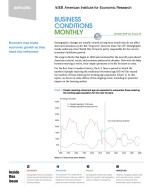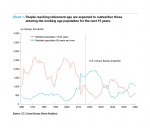October Business Conditions Monthly
Demographic changes are usually viewed as long-term trends that do not affect short-term business-cycles. But “long term” does not mean “far off.” Demographic trends underway since World War II may be partly responsible for the current economy’s lackluster growth.
The surge in births that began in 1946 and continued for the next 20 years altered American cultural, social, and economic patterns for decades. Now with the baby boomers starting to retire, their impact promises to be felt for years to come.
For the first time in modern history, the U.S. faces a period in which the number of people reaching the traditional retirement age (65) will far exceed the number of those entering the working age population (Chart 1). In this report, we focus on some effects of this ongoing trend, including its potential impact on the housing market.
Click for interactive Indicators at a Glance (on mobile device turn to landscape)







